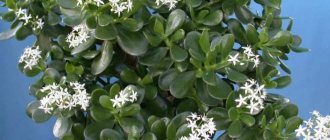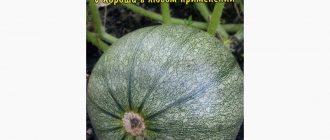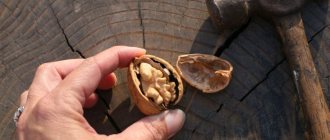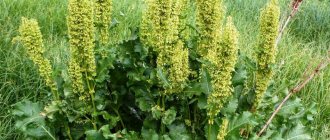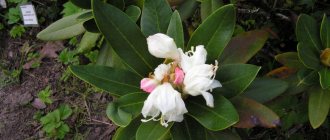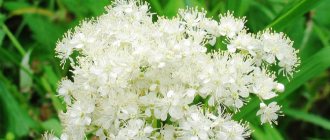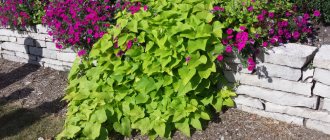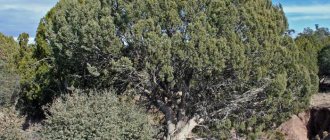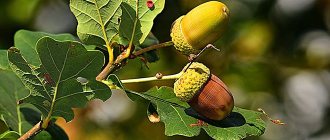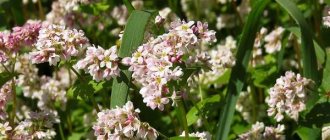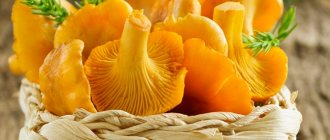Magician, guardian of the soul, black grass, bearberry, bogwort, black dropsy, crowberry, scarlet grass, bagnovka, ernik, tolkushka - these are the names awarded shiksha
for its healing properties.
Its pharmaceutical Latin name is “Empetrum nigrum”, in English it is called “Crowberry”, in German – “Krähenbeeren”, in Finnish – “Variksenmarja”, “Sianmustikka” (pork blueberry), in French – “Camarine” (crow berry). It is a member of the crowberry family (Empetraceae). And the name “ crowberry ” and its derivatives are given because of the saturation with fresh juice and the almost absence of pulp.
Shiksha berry: where does this plant grow?
Shiksha is widespread on our planet - both in the Southern and Northern Hemispheres. It can be found in Scandinavian countries and Western Europe. Shiksha grows in Canada and Chile, in the USA and eastern China, in Mongolia and on the Japanese islands.
The plant prefers cool regions, mountainous areas, tundra and the polar-arctic zone. Shiksha grows well in coniferous forests, in swamps, in thickets of moss, and often next to mushrooms. Thickets of shiksha, which are called shikshevniks, are found both on rocky mountain slopes and on sandy soils.
In our country, it is most often found in the Sayan Mountains, the Altai Mountains, Siberia and the Far Eastern regions, the Kuril Islands and Kamchatka.
Planting, care and propagation of plants
In the wild, shiksha can be found in sunny areas. The soil should be acidic sandy or peaty. Crowberry does not tolerate stagnation of water in the soil or dense soil. The clay soil on the site needs to be diluted with sand, peat or turf soil to make it suitable for planting shiksha.
Features of planting black crowberry:
- The plant is planted at a depth of 40 cm;
- The distance between bushes should be 30-50 cm;
- When planting, you need to water the crowberry well;
- The root collar of the crowberry should be buried 2 cm into the soil.
After planting, shiksha needs regular watering and weeding. But as the plant grows, it is watered only during the dry period. If you add a layer of peat, the moisture is retained much longer.
During the season you need to perform only one fertilizing with Nitroammophoska. Use 50 g of substance per 1 m2. In spring, dried and frozen stems need to be trimmed from the bush. Crowberry is a frost-resistant plant, so insulation is not required for the winter.
Reproduction is carried out by cuttings. Their optimal length is no more than 5 cm. It will take no more than three weeks for them to take root in the ground.
In the wild, shiksha can be found in sunny areas
Description
The shiksha berry, the beneficial properties of which have been known since ancient times to many peoples of the world, is a small shrub belonging to the Heather family. Its height does not exceed thirty centimeters. This is an evergreen plant that resembles a spruce with its branches.
The leaves of the plant are needles, reminiscent of conifers, dark green in color. They are hard to the touch, with the edges turned inward. They thickly cover all stems. The branches of this shrub spread along the ground, reaching a length of one hundred centimeters.
Types and varieties of shiksha
It must be said right away that there is no unified approach to this type of classification. Some botanists consider black crowberry to be its only species. - Empetrum nigrum. It, in turn, includes 2 types:
- Empetrum nigrun var. japonicum;
- Empetrum nigrun var. asiaticum.
According to other scientists, this genus includes:
- almost-holarctic shiksha (Empetrum subholarcticum);
- red crowberry (Empetrum rubrum Vahl). The relationship with the main species is proven by the fact that black berries can sometimes be seen on the bushes;
- bisexual crowberry (Empetrum hermaphroditum);
- black crowberry (actually Empetrum nіgrum).
Let's take a closer look at these varieties.
Black crowberry (Empetrun nigrum)
This evergreen shrub, reaching a height of 50 cm, has a cushion-shaped, highly branched crown. Its natural habitat is peat bogs. The ripening period for black crow berries is the last ten days of August – mid-September.
Crowberry (Empetrum hermaphroditum)
Refers to perennial plants that bear both male and female flowers. In botany they are usually called monoecious. One of the features of crowberry hermaphroditic shrubs, reaching a height of no more than 30 cm, is the ability to grow on the sandy terrain of the Siberian forest-tundra. There its shoots can grow over the surface of the earth for several meters. The fruits of the bisexual crow are of no culinary value due to their increased wateriness combined with a sour taste.
Red crowberry (Empetrum rubrum Vahl)
The predominant habitat is the South American continent. The fact that the berries are ripe can be recognized by their rich red color. The shrub has the same appearance as other varieties of crowberry.
Shiksha (berry): beneficial properties, photo
The first berries appear on the bushes in August. They can remain on the branches all winter. Densely covering the bush, they resemble blueberries - round, no more than five millimeters in diameter, black with a bluish tint. Under the dense shell (inside) there are up to nine seeds.
Shiksha is an edible berry. It is distinguished by its juiciness and pleasant sour taste. People often call it crowberry due to its high moisture content. In addition, in some regions it is called cabbage roll or crowberry (due to its bluish-black hue), crimson berry (for its bright red flowers), bear berry, since club-footed people enjoy feasting on it, and also psycho, due to its pronounced calming properties.
Shiksha is a berry whose medicinal properties are preserved when frozen. Fruit drinks, compotes, jams, and juices are made from it. This berry contains a huge amount of valuable substances, is perfectly preserved without heat treatment, and does not ferment at all, thanks to the benzoic acid included in its composition.
Features
Once you have seen this highly branched evergreen shrub with edible black berries hidden in a moss cushion by spreading stems reaching up to 100 m, it is impossible to forget its picturesqueness. The leathery leaves on crowberry branches look like spruce needles, from the axils of which dark red, small flowers appear in May-June. The fruits are a black spherical berry with a bluish coating, up to 55 mm in diameter, with 6-9 seeds and bright juice inside. They begin to ripen from August until late autumn, retaining a sour taste, located on the bushes all winter.
Medicinal properties
Many biologically active compounds and vitamins have been identified in shiksha, which have a strengthening effect on the human body. This is especially true for the nervous system. Shiksha is a berry whose medicinal properties are successfully used in both traditional and folk medicine.
It is known primarily for its powerful anticonvulsant effect, which is used in the treatment of epilepsy. In addition, its therapeutic effect is noted for certain types of nervous disorders, stress, nervous exhaustion, insomnia, and chronic fatigue syndrome.
Shiksha perfectly removes radionuclides from the body. The berry is used to make choleretic, phytoncidal, sedative, hypotensive and diuretic drugs.
Fruit
In mid-summer, green berries form from the ovary. As they ripen, they acquire a red color, then fill out and become bluish-black. This happens in August-September. The fruits are round, slightly flattened at the base. Their size is small - 5-6 mm. The skin is dense and tough. There are several seeds inside. When pressed, the berry releases a lot of juice of a beautiful purple hue. Crowberry tastes bland due to its high water content. The berries remain on the branches until spring.
Application
Shiksha has long been used to treat and alleviate various serious ailments by shamans, herbalists, and healers. The herb and berries were used for dropsy, due to its diuretic properties, headaches, paralysis, difficulty urinating, insomnia, metabolic disorders, seizures, including those associated with epilepsy, hypertension, chronic colitis, gastritis.
This valuable plant was also used to treat scurvy, because the berries contain much more vitamin C than lemon. Shiksha decoction is still successfully used today to rinse hair, which after several procedures becomes strong, shiny, and accelerates its growth.
Tibetan healers also use shiksha to treat diseases such as epilepsy, anthrax, some liver and kidney diseases, and neuropsychiatric illnesses.
Due to its unique composition, shiksha is used in pharmacology for the manufacture of dosage forms that are used in the treatment of diseases of the nervous system and brain. Nutritionists often recommend including shiksha in the diet of people prone to swelling, problems with urination and metabolic disorders.
Almost all parts of this plant are used in various recipes of traditional healers. For example, a decoction of leafy branches is recommended for problems with the nervous system. It is also effective for paresis, diabetic polyneuritis, colitis, and intestinal disorders.
One handful of berries completely replaces a sip of water. Animals eat them with pleasure, receiving the vitamins and nutrients necessary for their bodies. There is another important property of this plant that is relevant today. A strong decoction of shiksha berries will help get rid of one of the very common problems today - dry eye syndrome. It occurs most often in those who spend too much time in front of a computer monitor.
The pulp of the berries has found application in cosmetology. Compresses are made from it to treat various skin diseases (acne, wounds, ulcers). Crowberry berries improve metabolism and help with severe headaches (including migraines).
Almost all parts of the plant contain tannins, which provide bactericidal and astringent properties. The plant is used as an anti-inflammatory and hemostatic agent.
Introduction
At the time of ripening, from mid-August to the end of September, the tundra hummock grass is black and gray due to the abundance of this berry. So much so that you can’t even see the “Christmas tree” branches that the berries closely cling to. And local children walk around with black lips, teeth and tongue - shiksha has a very persistent pigment-dye.
The adult population collects this berry in large quantities for various purposes, including for preparing an intoxicating drink.
If you put it in a 20-liter glass bottle, half filled with berries, and fill the rest with water and sugar, then somewhere by the New Year, through simple manipulations with the water seal and double straining, you get an analogue of Cabernet - with a very similar taste, only darker .
Only due to the presence of a large amount of benzoic acid in the berry, which prevents fermentation, this process has to be started “by force” - with the help of yeast.
Decoction for epilepsy
To make it you will need:
- shiksha berries (50 pieces);
- boiling water (300 ml).
Pour boiling water over the berries and place the container in a water bath for thirty minutes. Remove it from the heat and, without removing the berries, leave it to steep overnight. Take this decoction eight times a day, one tablespoon (tablespoon). One important point: healers strongly recommend starting the reception at 8.00 and ending at 20.00. Children under 14 years of age are prescribed a teaspoon of this remedy at a time.
Cultivation, collection and storage
In artificial cultivation, seedlings are mainly used - the seeds germinate reluctantly, and growth to marketable condition takes a very long time. Rooted cuttings or seedlings are planted at a distance of 25-35 cm from each other. The root collar of the seedling is deepened by 2 cm or more. Watering is done moderately, and fertilizers in the form of nitroammophosphate are applied once a season in the amount of 50 g per m2.
Until the plant takes root and begins intensive growth, it needs to be weeded. For normal growth and development, acidic peaty soil is needed.
Wild and cultivated shiksha branches are collected during the flowering period of the plant, dried in dark, ventilated rooms, regularly turning the layers. The berries are collected during their ripeness. The collected ones are dried in ventilated dryers or frozen. Pickled berries also retain their beneficial properties for a long time.
X
Interesting facts about bear berries
Among the inhabitants of the North, especially those who lead a nomadic lifestyle, a popular dish is “tolkushka”, which is prepared for the winter. It is made from the berries of the plant, seal fat and chopped fish. Vladimir Dal mentioned it in the explanatory dictionary, calling it “Kirilka”.
Shiksha is a popular food for poultry and is also loved by deer and bears. In a number of regions it is listed in the Red Book, this applies to the Nizhny Novgorod, Tula, Smolensk, Kostroma regions and some others.
Black crowberry is also popular among the indigenous people of America. Indians, just like residents of Siberia, actively use it in winter. But in addition to the fruits, they also use shoots with leaves of the bush, preparing infusions and decoctions from them to treat digestive disorders.
Shiksha is often used in traditional Tibetan medicine; here it serves as a cure for various kidney and liver diseases, and nervous system disorders.
The plant has dark red stems and curled oblong leaves. The purple flowers consist of several petals and are unisexual. The shrub blooms in spring and can bear fruit for up to 100 years throughout its entire life cycle.
Watch the video about black crowberry:
Recipes for dishes with black crowberry
Fresh crowberry can be sprinkled with sugar and eaten in its pure form. It also goes well with dairy products: yogurt, curd mass, fermented milk cheese, yogurt, milk, kefir. It is recommended to store it in glass containers. The fruits of the plant make delicious preserves, jams, compotes, jams, which can be used both for consumption with tea and as a filling for pies, pies, buns and other baked goods.
Let's look at recipes for delicious dishes with black crowberry:
Jam
. First, peel the apples (1 kg), then pour boiling water over them and leave for 30 minutes. After this, cut the fruit into small pieces, place in a blender bowl and grind until smooth. Then wash the black crowberry berries (1 kg), cover them with sugar (1.5 kg) and leave covered for 2 hours. After this time, put the mixture on low heat, cook for 30 minutes, stirring, and add the prepared applesauce. Bring the mixture to a boil and keep on the stove for about an hour. When it is ready, pour the jam into pre-sterilized jars, roll up and turn upside down. Leave the jam in this form for 2-3 days, then put the crowberry in the basement, if you have one, or put it in the refrigerator.
Jelly
. First, blanch the berries for 2-3 minutes in boiling water, then strain them and squeeze out the juice. Add sugar (150 g) and citric acid (2 g) to it (1 glass), place the mixture on low heat. When it starts to boil, add gelatin (30 g), while stirring the mass. Then boil the jelly for about 5 minutes, remove from the stove, transfer to special molds and place in the freezer for an average of an hour.
Recipes
a decoction and infusion from crowberry . Usually the drugs are used internally. This is why it is important to follow the recipe.
Sequence of preparing the decoction:
- Take 2 tablespoons of herbs and chop;
- The herbs are poured onto the floor with a liter of boiling water;
- The container is placed on fire;
- The broth simmers on the stove for 15 minutes, after which it is cooled;
- Filtration is performed using a sieve or gauze.
The shelf life of the decoction is no longer than 3 weeks. For infusion, take one tablespoon of crushed crowberry and add 200 ml of boiled water. Then the mixture is left for 20 minutes. The product should cool slightly, after which it is filtered and drunk. Shelf life – 2 days.
Vitamin berries will help strengthen the immune system, and decoctions and infusions from the shoots have medicinal properties. They are useful for mental disorders, diseases of the intestines, kidneys, and liver. The plant is easy to care for, and the recipes are simple, which makes shiksha accessible to everyone.
- Author: Maria Sukhorukikh
Rate this article:
- 5
- 4
- 3
- 2
- 1
(0 votes, average: 0 out of 5)
Share with your friends!
Contraindications of shiksha
Like all plants, there are both benefits and harms to consuming shiksha.
It is not recommended for women to take during pregnancy and breastfeeding. People with hypersensitivity should also be wary of using medicines containing shiksha extracts.
We recommend reading: The benefits and harms of canned corn, how many calories, recipes
How to grow crowberry or crowberry or crowberry from seeds
Crowberry seeds crowberry photo
When propagating from seeds, there are no difficulties - the seeds germinate well, and admiring the seedlings is a pleasure.
When to plant crowberry seeds in the ground?
You can sow the seeds directly into the ground in early spring under a film cover, but in this case, further care of the sprouts is difficult. This method is rarely used.
When to plant crowberry seeds for seedlings?
To get crowberry seedlings by spring, plant the seeds for seedlings at home. It is better to start planting crowberries in the fall, but no later than February-March.
- Prepare individual cups with a volume of at least 0.5 liters, make drainage holes, lay a drainage layer of sand and fill the cups with universal soil for seedlings, which can be mixed in half with peat.
- Plant the seeds one at a time in a cup, to a depth of 1 cm.
- Moisten the soil and cover the crops with cling film.
- Germinate seeds at a temperature of 16-18°C, do not allow the crops to overheat. The plant comes from the tundra, where it is not too hot.
- When the shoots appear, remove the film and place the seedlings on a cool, bright window or glazed loggia, where the temperature will not drop below +10°C.
- Continue further care, maintaining moderate substrate moisture.
- Take the plants outside or onto the balcony, simultaneously hardening them and providing them with the necessary coolness (the air temperature needs to be above +10°C).
Grown seedlings are planted in the ground as soon as the threat of night frosts has passed.
Shiksha application recipes. Medicines from shiksha and treatment of diseases
When applying the benefits of Siberian shiksha, keep in mind the contraindications to its use (see below)!
Crowberry (the second name of this plant) is useful for both men and women. The active substances contained in the herb relieve migraine attacks, and the anti-inflammatory effects inhibit inflammation, particularly in the prostate area.
Let's look at recipes for preparing homemade medicines from Siberian shiksha, and learn how to take them for various diseases.
Tincture against epilepsy
There are several ways to prepare a tincture used to treat epilepsy.
Recipe No. 1 – alcohol tincture
Place the greens in a glass jar and fill with alcohol (40-50%) or vodka. Leave to infuse for 10 days. Shake daily. After the specified time has passed, strain. Take 1 tsp. 3 times a day.
Recipe No. 2 – wine tincture
Pour 100-150 g of raw material into 1 liter of wine (preferably red). Leave to infuse for 10 days. Shake daily. After the specified time has passed, strain. Drink a glass (about 30 ml) 3 times a day.
This remedy, in addition to epilepsy, is recommended for depressive conditions and chronic fatigue syndrome.
Recipe No. 3 – fruit decoction
For epilepsy, you can use the healing properties of berries in the form of a decoction. It must be prepared in the evening. Pour 250 ml of boiling water over 60 berries. Leave in a water bath for 30 minutes, leave overnight. Strain in the morning.
Take 1 tbsp. 6-7 times a day (for adults) or 1 tsp. the same number of times.
Kidney diseases
Tea made from the leaves will help eliminate kidney diseases. Making the drink is easy. Pour 1 liter of cold water into 3-4 tbsp. raw materials. Bring to a boil. Cool slightly, strain. Have a drink.
Morning intake is recommended for kidney disease, evening intake for chronic fatigue syndrome and fatigue (physical and mental).
Migraine and headache of other etiologies
To relieve migraine attacks and eliminate other headaches, use the following remedy: Boil 2 tablespoons for a few minutes (about 5 minutes). leaves in 1/2 liter of water. Leave for 1 hour. Take 3-4 tbsp. 4-5 times a day.
Withdrawal syndrome
Siberian shiksha will help relieve the symptoms of withdrawal symptoms after quitting alcohol, tobacco, and drugs. The medicine is completely tasteless, but, according to reviews, it is effective.
4 tbsp leaves, pour 1 liter of whey, bring to a boil. Leave in a thermos for about 30 minutes. Drink 250 ml 4-5 times a day.
Sleep disorders, anxiety
The calming effect of crowberry will help get rid of insomnia, anxiety, and stress. Use the decoction prepared according to the following recipe.
Pour 1/2 liter of boiling water over 1 tbsp. leaves, cook briefly. Take 2 days (6 times a day, 3 sips). Refill the remaining raw materials with boiling water and continue taking.
Ophthalmic diseases
Siberian shiksha is a good remedy for the treatment of eye diseases, in particular visual impairment, cataracts, glaucoma, and dry eye syndrome.
1 tbsp. greens, pour 1/2 liter of boiling water, strain after 30 minutes. Use the infusion as eye drops - 3 drops in each eye, 4-5 times a day. Therapeutic course – 3 months.
Allergy
To eliminate allergy symptoms, incl. seasonal, it is recommended to use crowberry as a component of the plant mixture. Prepare an infusion of equal amounts of the following herbs:
- Siberian shiksha;
- Sophora;
- red brush.
2 tbsp. Infuse the mixture in 1/2 liter of boiling water for 1 hour. Drink 1/2 glass 2-3 times a day.
Homemade medicine
To prepare homemade medicines, you can use the raw materials you collected yourself or purchase ready-made ones. The instructions for the pharmaceutical herb recommend the following method of preparation and use: 1 tbsp. herbs, pour 1/2 liter of water, cook for 6-7 minutes.
Take the resulting medicine 2-3 sips 6 times a day for 2 days. Refill the remaining raw material with water and repeat the boiling and receiving process.
Continue the treatment until the active substances are released into the broth (this can be determined by the green color of the liquid). Natural medicine is recommended for the following health problems:
- Edema.
- Dropsy.
- Mental disorders (schizophrenia).
- Epilepsy.
- Depressive states.
- Scurvy.
- Diarrhea.
- Chronic gastritis.
- Colitis.
- Metabolic disorders.
- Paralysis.
- Cramps.
- Difficulty urinating.
External use is advisable for problems such as:
- Acne.
- Rash of various origins (including allergic).
- Furunculosis.
- External ulcers.
- Wounds.
Shiksha helped us. Benefits, medicinal properties and contraindications for consuming shiksha
well known in both hemispheres of the Earth, its fruits have long been used as food, and shoots with leaves, flowers and fruits are used for medicinal purposes.
The indigenous inhabitants of Kamchatka, the Kuril Islands, and the mainland Far East - the Itelmens, Koryaks, Chukchi and others - prepare a dish called selaga, tolkush, kylykil from boiled salmon, shiksha berries and seal or seal fat.
The subshrub is widespread, it can be found in Scandinavian countries, throughout Europe, Asia Minor, Japan, Mongolia, the USA, and Canada. In Russia, it grows in Altai, in the Sayan Mountains, throughout Siberia, in the Far East, the grass grows even in the tundra and polar zones.
Description of shiksha and its composition
Shiksha, also known as black crowberry, is a perennial evergreen creeping subshrub from the Heather family. Grows up to 30 cm in height. The dark green leaves of the plant look like pine needles, the branches crawl along the ground, reaching a length of up to one meter. Outwardly they resemble spruce paws. It blooms in April-May with small bright pink and red flowers. The fruits ripen in August and can stay on the bush all winter. The berries are very similar to blueberries in the shape of the fruit and their color; the taste of the fruit is sour, very watery.
Synonyms for the name are Siberian crowberry, Altai crowberry, ssykha, scarlet berry, pork blueberry, crow berry, bear berry, and others.
Biochemical composition of the plant:
- tannins;
- organic saturated and unsaturated acids;
- colored plant glycosides (anthocyanins);
- coumarin compounds;
- terpene and triterpene substances;
- essential oils;
- polysaccharides;
- mineral microelements, macroelements;
- complex of vitamins;
- waxy substances;
- resinous components, alkaloids.
Useful properties of shiksha
Shiksha berries and leaves have many beneficial and medicinal properties.
- Active substances together with a vitamin complex improve immunity, help cope with vitamin deficiency and chronic loss of strength.
- Essential oils, terpene compounds, coumarins alleviate and relieve headaches of various types, neutralize nervous tension, mental disorders, and prolonged depression. Has an anticonvulsant effect.
- Anthocyanins have an anti-inflammatory, diuretic effect in cases of diseases of the kidneys, bladder, and urinary systems.
- Tannins, anthocyanins, and organic acids have a healing, anti-inflammatory effect on ailments of the stomach and digestive tract, and have a beneficial effect on the condition of the liver, helping it get rid of toxins.
- Crowberry has wound-healing, antiseptic properties in the treatment of skin diseases and wounds. Suppresses the development of putrefactive bacteria.
- Relieves eye irritation due to fatigue, treats eye diseases.
Use in folk medicine
Due to its beneficial properties, shiksha grass has found wide use in the treatment of various ailments.
- Infusion for headaches: pour half a glass of boiling water over crowberry leaves and shoots (2 tablespoons) for 25-30 minutes under the lid. Filter, dilute 20 ml of infusion in 100 ml of clean water. They drink three or four times a day.
- To improve metabolism and lower blood pressure: boil a tablespoon of chopped crowberry leafy shoots in half a liter of water for 10 minutes. Filtered. Drink 20 ml every 4 hours for two days in a row. You can repeat it every other day.
- For nephritis, inflammation of the renal pelvis, to relieve swelling: bring 3 tbsp to a boil. spoons of finely chopped crowberry leaf in a liter of water, remove from heat. Strain after 10 minutes. Drink a glass of infusion in the morning on an empty stomach.
- Extract for a tonic, soothing bath: simmer in 6 liters of boiling water under a lid, insulating it, 50 grams of dry crowberry leaves and shoots for 12 hours. Pure infusion is poured into bath water (water temperature 36-38°C). The procedure takes no longer than 40 minutes, and should be done every other day or two for a month.
- Treatment of depression, neurosis, epilepsy: boil 3 tablespoons of dry crowberry herb in 1 liter of water for 10 minutes. Pour into a thermos for 1.5-2 hours, cool, squeeze out the cake. Drink 20 ml, diluted in a glass of water, morning and evening.
- Strengthening the immune system, scurvy, dysentery: it is recommended to eat the fruits of the plant (fresh, dry, frozen) every day, 150-200 grams.
- Drops for the treatment of eye diseases: simmer 1 tablespoon of raw material in 50 ml of boiling water until completely cooled. Squeeze out the pulp and filter the infusion. 2 drops of herbal infusion are dripped into each eye 6 times a day for 4 weeks. For eye fatigue, the procedure is carried out within a week.
- Treatment of dermatitis, skin rashes, inflammations: boil 5 tbsp. spoons of crowberry leaves in a glass of water for 10 minutes. A gauze cloth soaked in a clean broth is applied to the affected area. If furunculosis is being treated, the cake is wrapped in a gauze cloth and applied warm to the boil.
- Strengthening hair roots, against dandruff: rinse clean hair with a strained infusion of 4 tablespoons of raven's eye in 0.5 liters of boiling water (60 minutes).
Berry - crowberry
Where and how does lingonberry grow?
Crowberry berries ripen from late August until frost, after which they acquire a sweeter taste. When fresh, crowberries can be stored for a long time, almost until a new harvest, without releasing juice.
The harvest of crowberries depends on a number of factors, primarily on the climatic and soil conditions of growth.
The dye obtained from crowberry berries is a dark red liquid with a sour, slightly tart taste. The crowberry dye is completely soluble in water. Its aqueous solution is transparent.
The technology for producing dye from crowberries was developed mainly in laboratory conditions. The quality of the dye allows it to be used for coloring confectionery and other food products with an acidic environment. Provided the collection of wild crowberries is organized, the possibility of introducing dye manufacturing technology into industry is beyond doubt.
To study the durability of crowberry dye during storage, confectionery products colored with it were kept during the warranty period in conditions that met the requirements of the standard for each type of product.
The experimental results show that crowberry dye can be used to color acidified caramel mass in pink and red colors of varying intensities.
From the data in the table it follows that the dye No. of crowberries contains on average 44% dry substances, coloring substances - 48 - 51 g / kg. This basically meets the norm for natural dyes used to color confectionery products.
The chemical composition of the dye is determined mainly by the chemical composition of the raw material - crowberries, from which it is prepared. However, since the dye is the juice of crowberries concentrated under vacuum by about 4 times, the content of the constituent chemical components in the dye is much higher.
Thus, based on the research carried out, we can conclude that crowberries can serve as a new type of plant material for producing natural red food coloring, approved by the USSR Ministry of Health.
As a result of experiments, it was established that for coloring marshmallows, the consumption of crowberry dye is 12 g per 1 kg of marshmallow mass, for coloring marshmallows - 10 g per 1 kg of floor mass.
When discussing the results of these experiments with factory workers, it was noted that crowberry dye should be recommended for coloring products such as marshmallows and marshmallows.
The results of the research performed can be used in the development of regulatory and technical documentation for natural food coloring from crowberries. Draft technical specifications for red concentrated food coloring from crowberries have been prepared.
The table data shows that the optical density of solutions of samples of sugar dragee and candy caramel, colored with crowberry dye, changed slightly during storage. These changes in the color of painted products when stored during the warranty period are visually almost invisible.
Crowberry berries ripen from late August until frost, after which they acquire a sweeter taste. When fresh, crowberries can be stored for a long time, almost until a new harvest, without releasing juice.
The results of the research performed can be used in the development of regulatory and technical documentation for natural food coloring from crowberries. Draft technical specifications for red concentrated food coloring from crowberries have been prepared.
Features of crowberry
Crowberry is a creeping small shrub that reaches only 20 centimeters in height. The length of the stems can reach 1 meter. This plant is similar in characteristics to lingonberries. This shrub grows in clumps, while its branches can grow adventitious roots, due to which the clump constantly grows, while the branches located in the middle of the bush gradually die off. Strongly branching shoots are dark brown. Alternately arranged leathery leaf plates are similar in appearance to spruce needles; they densely cover the shoots. Each of the leaf plates does not fall off the bush for 5 years. Axillary flowers have 3 petals, which can be colored red, purple or pink. These flowers are inconspicuous. In mid-latitudes, shiksha blooms in April or May, while in Siberia - in May or June. For pollination, such shrubs require pollinating insects, such as bees, butterflies and flies. Externally, shiksha berries are similar to blueberries. They are juicy, sour fruits, spherical in shape and black in color, which can reach 5.5 cm in diameter, have 4 seeds inside, and a bluish coating on the surface. They begin to ripen in August, and they do not fall off the bushes throughout the winter. The juice obtained from such fruits is purple in color. Thickets of crowberry are called shikshevnik or crowberry.
Related article: Daffodil bulbs: when to buy and how to store, propagation and treatment for diseases
This plant is also distinguished by another feature: it grows in symbiosis with a special fungus. It settles in the root system of the bush and supplies it with photosynthetic products.
How to eat black crowberry?
You can use both berries and leaves, and some even put sprigs of the plant in tea. The fruits are collected after ripening, in August. Then they can be frozen by rinsing them with clean water, spreading them into containers in a thin layer and placing them in the freezer. You can also cover the berries with sugar in layers and then store them in the refrigerator.
Soaked shiksha is very popular; for this purpose, the berries picked at the end of the harvest are washed and filled with clean water, placed in wooden barrels, covered with a press and placed in the basement. Here they can be stored on average for about 10 months, until the next season.
Twigs and leaves are also prepared in advance; for this purpose, they are dried in the sun or in the oven, put in a bag, hung from the ceiling and stored in a warm but dry place. It is best if it is made of cotton. In this case, you need to remove the shoots carefully, using scissors, so as not to harm the bush. Approximately every 2 months the bag with the preparation needs to be shaken, and after 2 years it is no longer recommended to use it.
Shiksha for depression. How to get rid of depression
Depression is a serious condition that often cannot be cured from the outside; for this, the patient himself must want to be cured and take some steps for this. The way out of depression should be the “You Way”, that is, you should not rely on the help of good doctors and newfangled drugs, which often do not give the desired effect, but act independently. To do this, people who have overcome depression themselves recommend: 1. Physical exercise. It has long been known that when playing sports, endorphins are produced in the body. And systematic physical exercise allows you to quickly get out of depression. Of course, in a depressed state, it is difficult to force yourself to get out of a warm, cozy bed an hour earlier than the alarm clock on a gray, damp morning, get dressed and go jogging. Even doing exercises is often difficult, even if the most strict vows were made in the evening to start a new life in the morning. But as they say: “if you can’t get up, fall to the floor,” so in order to break out of this viscous state of depression, you need to gather all your strength and take up some kind of sport. Knowledgeable people note that it is running that allows you to escape from problems and difficult thoughts, focusing only on the process of running and the feeling of the second, then and third wind. And while jogging, the brain is simply not able to be distracted by other thoughts, which gives a person the desired respite. 2. Fasting. A very strong and radical method, which was widely used in Soviet psychiatry, but is now a little forgotten. During fasting, processes occur in the human body that affect not only the physical, but also the psychological spheres. Representatives of the fair sex especially love this method, since it not only helps relieve depression, but also lose a couple of extra pounds. You should fast under the supervision of a doctor, you should start from a couple of days, subsequent courses can last up to 3 weeks. For some, depression completely disappears, especially after long courses; for some, it returns after a certain time. It should be remembered that it is impossible to fast and lead a normal lifestyle due to frequent weakness, so it is better to use weekends or vacations for this. 3. Light treatment. A large number of people experience depression during the cold season due to a lack of solar energy. In such cases, light therapy courses using lamps, the light of which is comparable to the rays of the sun on a warm spring day, are very helpful. In Europe, special lamps are sold, but here they can be replaced with illuminators from stores for photographers. 4. Sleep deprivation. This method was first used in Ancient Rome, then it was forgotten and rediscovered in Switzerland in the 20th century. Now the method is not very popular, but is still effective. It consists of the fact that on a certain day the patient does not go to bed at the usual time and remains awake throughout the night and the entire next day, and the next evening falls asleep as usual. The main thing in this method is to combat periods of drowsiness, which is especially difficult at 3-4 o’clock in the morning. At such moments, you need to give up quiet activities and start actively moving, cleaning or doing exercises. You should not miss more than one night, because then the person begins to fall asleep spontaneously, and dizziness and hallucinations may begin. If you act correctly, depression goes away the first time in half of the experimenters, so this is a very good chance to get rid of a depressed state. Often, medications for the treatment of depression do not bring relief, and then the person’s cure depends only on him.
